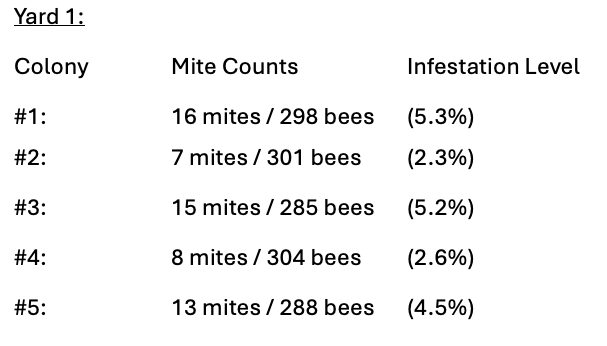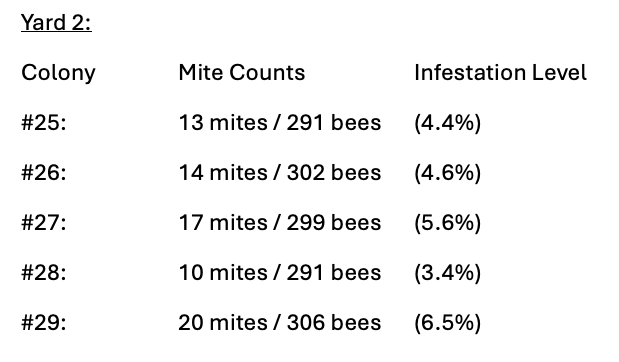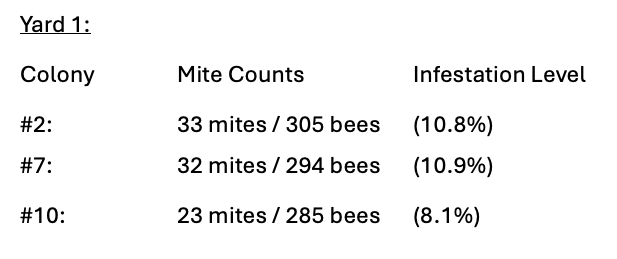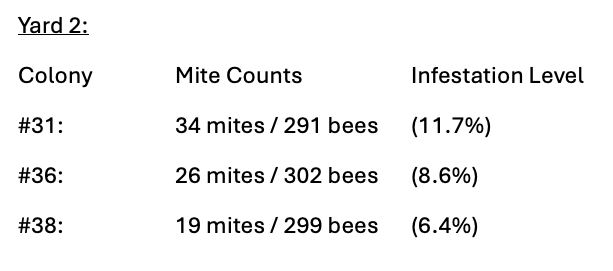“What Happened in my Bee Yard?” – Case Studies in Varroa Management
We would like to introduce you to a new series in our VP Newsletter, intended as a learning tool for beekeepers and beekeeping inspectors or advisors. In this series, we will present examples of beekeepers’ real-life reports about their varroa treatment experiences. Some of these reports are real anonymized cases – others are fictional but based on realistic scenarios that have been described to Véto-pharma throughout our many years in this industry.
A beekeeper calls mid-September, their voice frantic.
“I treated all of my 52 colonies with Apivar at the end of July, on the 28th… . But the treatment didn’t bring mite numbers down. When I removed the strips last week, I even noticed worker bees with deformed wings in some of my hives. I ended up sampling five (5) colonies in both of my bee yards and did sugar shakes to estimate the mite count. These were the results I saw for the ten (10) colonies I looked at:


I don’t know what went wrong with my Apivar treatment. Could the mites in my colonies be resistant to amitraz? How can I make sure my colonies will survive the winter now?”
Whenever we receive reports like this, we try to investigate what led to the specific treatment experience described by the beekeeper. We try to gather as much information as possible about the product used (lot number, manufacturing date, etc.), storage conditions, details of the application (dosage applied, treatment duration, etc.) and other actions and events before, during and after treatment that may have affected the treatment outcome.
In this case, we were able to clarify quickly that the product used (purchased 2 x 60-packs of Apivar strips produced a year prior to the application) was not expired and stored as recommended (in a cool, dry location) before it was applied. There were no variations in any of the quality parameters recorded before the Apivar strips of this lot were released from the manufacturing site.
We then proceeded to ask the beekeeper questions about the application itself:
– A total of 52 colonies were treated: 24 colonies in Yard 1 and 28 colonies in Yard 2.
– Double Deep Langstroth hives.
– The recommended dosage of 1 Apivar strip per 5 FoB (Frames of Bees), which translates into 4 strips per colony in this case.
– In the center of the brood cluster and for 6 weeks, the recommended minimum treatment duration.
Although none of these answers indicated any mistakes in the application process, the last response made us pause. In late July, when the beekeeper applied Apivar in this case, there is usually still a lot of brood present in honey bee colonies and, upon asking, the beekeeper confirmed to us that his hives were full of bees and brood at the time of treatment application. A substantial brood area at this time of year usually goes along with many hidden varroa mites – under the brood caps. Because of high varroa mite infestation levels at this time of the season, we usually recommend leaving Apivar strips on for the full eight (8) weeks for a summer treatment [note: 8 weeks is the maximum number of weeks authorized in the USA for Apivar – this duration may vary in other country, depending on the registration]
However, convinced that there was more to this case, we now started asking the beekeeper about the history of these colonies before Apivar was applied. These were our questions:
– A formic acid treatment in spring (mid-April) the previous year, then an Apivar treatment in mid-July, five (5) applications of oxalic acid vapor in October and November.
This year in spring: another formic acid treatment, but this time in late March, since mite infestation levels seemed higher than anticipated early in the season. The Apivar treatment was applied about two weeks later than last year, at the end of July. In both years, splits were made in May and sold to other beekeepers.
– Not for the exact same / all the colonies that were monitored after the 6-week Apivar application, but infestation numbers for a total of 6 colonies (3 per bee yard) are available.


From the responses to these two questions, we get a better picture of what may have been the problem in this case.
First, we are glad to hear that other treatments than Apivar have been incorporated in the beekeeper’s treatment strategy. Clearly, he has been rotating varroa treatments with different active ingredients – which is an important prerequisite for a successful varroa treatment strategy.
We also recognize that the beekeeper has made some efforts to monitor his colonies’ varroa mite infestation levels. He has performed sugar shakes, not only after the Apivar treatment, but also before – at least on some of his colonies.
Our advice for the future would be to:
The next piece of information we focus on is the difference in treatment timing between the two seasons. In the previous season, the formic treatment was applied about two weeks later than in the current season. At the same time, the Apivar treatment in summer was applied two weeks later – at the end of July vs. mid-July in the previous season. In addition, the beekeeper reports no mite monitoring between early spring (before the formic treatment) and July (before the Apivar treatment. How much did the infestation level increase between spring and summer? We do not have this information, and between late March and the end of July, the mite infestation in these colonies is like a black box to us (and the beekeeper).
Here, we add our fourth recommendation for the future:
Looking at the reported mite counts themselves; we are quickly approaching the elephant in the room. Unfortunately, the only colony monitored before and after the Apivar application is colony #2 from Yard 1. We can see that the infestation level before treatment was 10.8%, and the 6-week Apivar treatment reduced the infestation level to 2.3%. This corresponds to a decrease in the level of infestation of 78.7% after 6 weeks.
Nowadays, recommended treatment thresholds for a summer varroa treatment application mostly range between 2-3%. Although it is understandably not always possible for beekeepers to meet these thresholds exactly, it is recommended to not let mite numbers exceed the threshold by more than just 1-2%. Late summer varroa mite infestation levels of >5% are widely accepted as damaging to the extent that winter colony survival may be in question at this point. With a combination of different chemical varroa treatments and possibly some hive management techniques such as late season splits, there is still a possibility to bring such colonies through the following winter alive.
However, in this case we are looking at a mean pre-treatment infestation level of 9.4% across both bee yards. The post-treatment infestation mite level is 4.4%. But the sampled colonies did mostly not overlap between pre- and post-treatment monitoring.
Our fifth recommendation for a future varroa treatment strategy is therefore:
Based on the information regarding the treatment duration we may add:
As an immediate (emergency) recommendation to reduce varroa mite infestation in his colonies further, we recommend the beekeeper should apply a formic acid treatment, since the daytime high temperatures in his region are mild now, but not too low for sufficient efficacy (18°C / 64.4F – 21°C / 69.8F).
In addition, we recommend to sample 5 other colonies per bee yard for pre- and post-treatment monitoring (the same ones before and after the formic treatment). This will allow the beekeeper to monitor treatment efficacy more precisely and to decide whether another treatment may be necessary after this treatment or before the overwintering period. In any case, another round of monitoring is recommended for about 4 weeks after the completion of the formic treatment to decide whether a fall or early winter treatment should be applied as well.
Regarding the beekeeper’s initial question about amitraz resistance in his colonies, we come to the conclusion that it is unlikely in this case. The beekeeper clearly rotates active ingredients on a regular basis. The Apivar treatment has apparently reduced infestation levels significantly. Unfortunately, we can only demonstrate the mite reduction in one of the colonies, colony #2 of yard 1 (78.7% reduction of infestation level). Considering the overall circumstances such as high pre-treatment mite levels, Apivar application for only the minimum treatment duration of 6 weeks in summer, and observation of some individuals with deformed wings after the treatment, we believe that this case is most likely rooted in a lack of consistent mite monitoring in combination with fast varroa population growth during the current season.
We hope this case offered you a first glimpse of the challenges that varroa infestation can pose, even to beekeepers who read the packaging leaflets of their varroa treatments, store and apply products correctly (in compliance with the label), and rotate active ingredients. Varroa management is complex, and it has become more difficult in recent years. There is no shame in making mistakes along the way. The important part is to document hive management actions including varroa treatments, exchange with others (beekeepers, inspectors, and varroa treatment manufacturers), and learn by doing to eventually develop a successful varroa treatment strategy that can be adjusted from one season to the next.
We would love to hear your first impressions of this case study! Did you enjoy it? Is it something you’d like to see more often in our newsletter? Click here.
 by Juan Molina
by Juan Molina  by Véto-pharma
by Véto-pharma